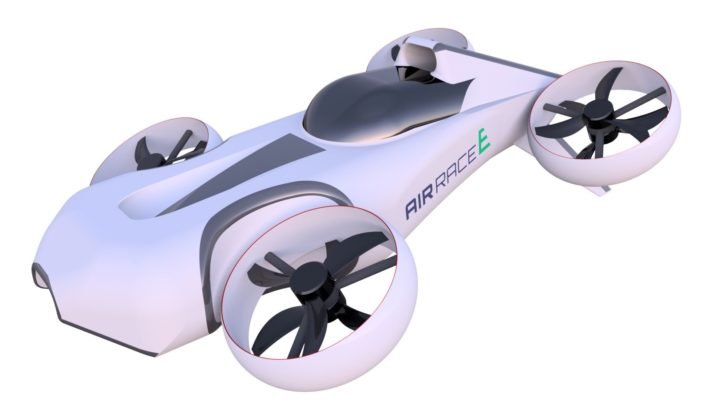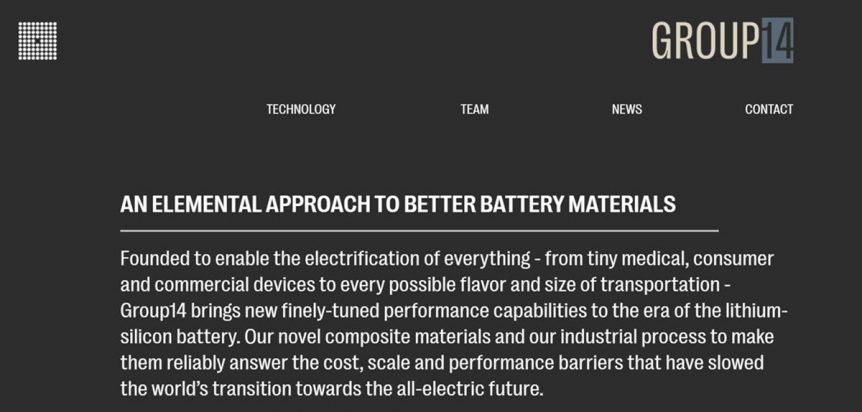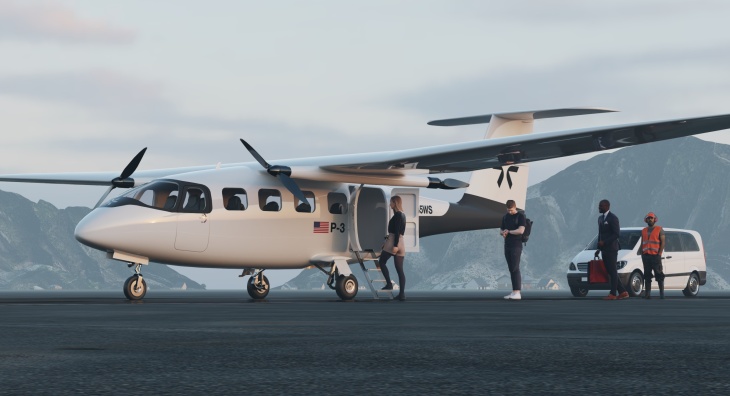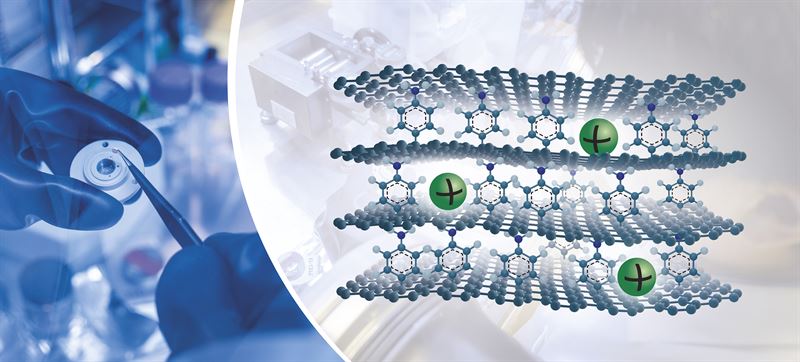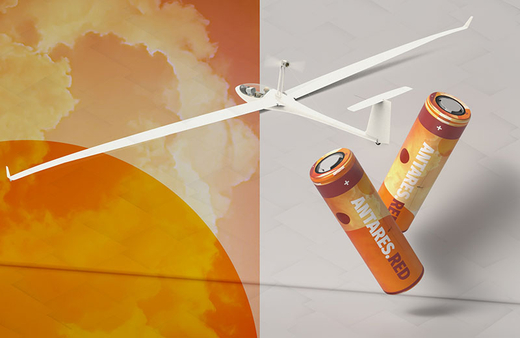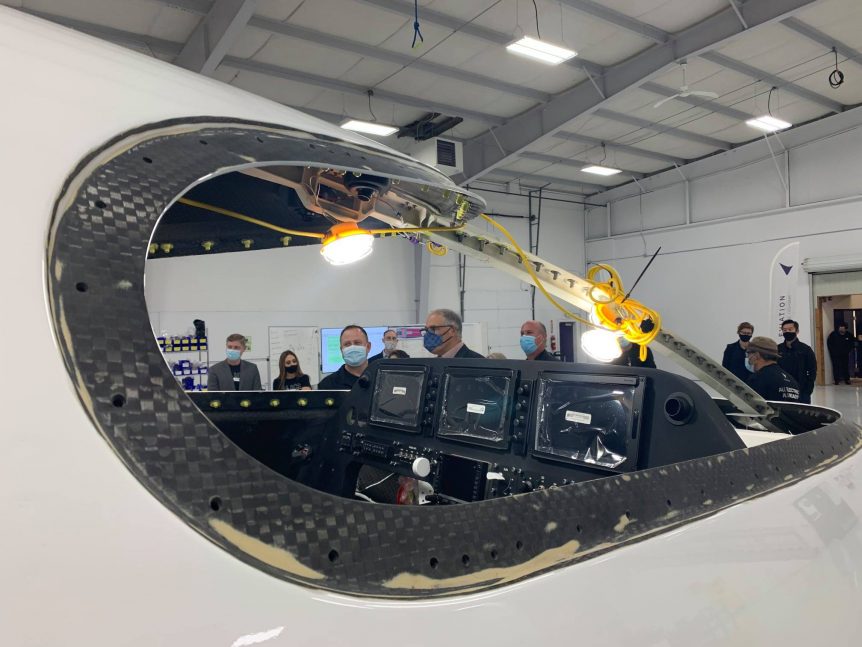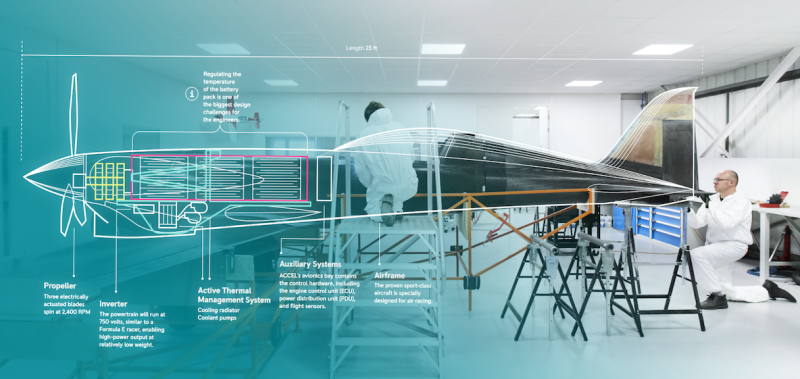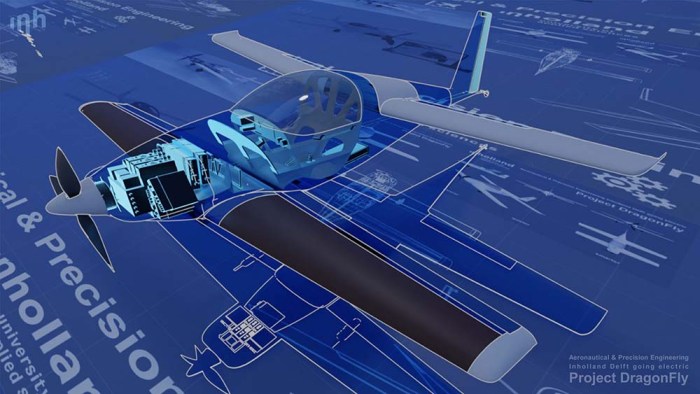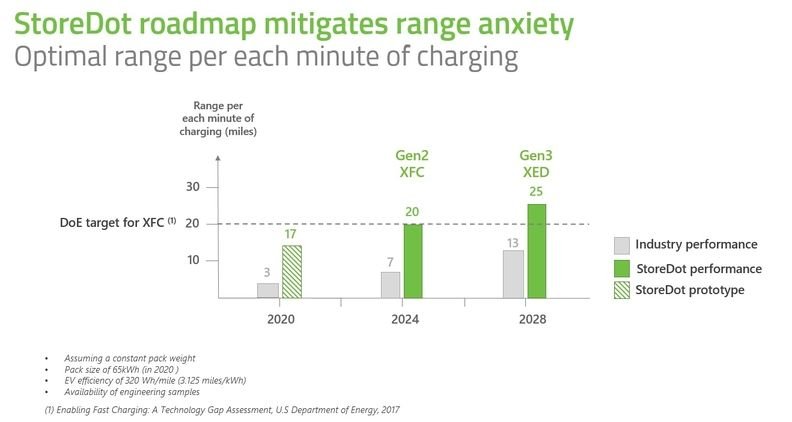“The electric VTOL class is an entirely different category of aircraft altogether. Often referred as “flying cars”, this type or aircraft is at the forefront of electric technology in aerospace. Brace yourself for The World’s First Vertical Motorsport! This race format and its rules will be somewhat different than the airplane classes and will be revealed soon.” Air Race E promotion. Possible Contenders The Alauda Airspeeder Two possible contenders (mostly) ready to race come to our attention. The first is the Alauda Airspeeder, shown here in its Mk. 3 version. And by dint of the International Dateline, the craft’s most recent flight came to us the same day it was recorded. One may question how open-rotor racing at high speed can be made safe. Alauda alludes to Acronis Cloud Protection. “The racing series, created by performance electric flying car manufacturer Alauda, will receive technical and commercial support from Acronis, with some of the services delivered by a global provider of …
Group 14: The Next Battery Innovation?
Tina Casey, writing in Clean Technica, reflects on the coming changes in the “gasmobile” to EV ratio. “Somewhere in the outer reaches of talk radio, a ghost stalks the halls, mumbling of light bulbs and plastic bags and electric cars that won’t start in cold weather. Meanwhile, most automakers are not waiting around for the other shoe to drop. They have finally begun pivoting into the sparkling green world of zero emission personal mobility, even those once wedded to the idea of ‘clean diesel,’ and a new battery formula is here to help.” Her article, “Game Over For Gasmobiles: Electric Vehicle Batteries Just Keep On Getting Better,” describes efforts at Group 14, the second of two electric vehicle firms recently visited by Washington Governor Jay Inslee. The first was Eviation, based in Arlington. SCC55™ Group 14 is reputedly, “The largest manufacturer of lithium-silicon battery materials,” capable of producing 120 tons per year of SCC55™, its patented battery anode material. SCC55, …
EmbraerX and Pyka Team Up
Accelerating Innovation Embraer, a major Brazilian airframe developer, and Pyka, an Oakland, California-based autonomous agricultural aircraft builder, are teaming up. They hope, “To accelerate the future of autonomous aerial agriculture operations.” Beyond that, Pyka is expanding into regional air transport which could open 5,000 U. S. airports to usually unserved areas. Pyka has flown autonomous agricultural aircraft in New Zealand for over two years, demonstrating high efficiency and economy in aerial application, or crop dusting (or spraying) as it’s historically called. Apparently, the island nation’s Part 101 and 102 civil aviation licensing requirements are receptive to such flight. According to Dan Grossman, Pyka’s new President (and formerly of Zipcar, Ford and Maven), Pelican made more than 3,000 flights. Airframer.com reports, “Grossman joins a team of former Joby Aviation, Google, Wisk, Makani and Saildrone engineers and leaders. ‘Electric and hydrogen propulsion technologies are playing an increasingly important role in the future of human mobility,’ he says. ‘Pyka’s benchmark-setting electric propulsion systems, …
Graphene Sodium-Ion Batteries with 10X Energy
Graphene, applied in a sodium-ion battery may herald inexpensive alternatives to lithium-ion cells. Scientists are exploring ways of making batteries not only more energy-dense, but also less costly. Sodium, a primary ingredient in table salt, is one possibility. It’s also abundant without too much effort required to find it. On the other hand, easily-obtainable lithium may become in short supply at a time when the world is clawing its way into the earth searching for more. Sodium is the sixth most abundant element on earth, making up about 2.6 percent of the planet. It’s never found free in nature, but always as part of something like the salt (NaCl) one can see it crusting over from evaporating bay water near Moffett Field, California, or in the Great Salt Lake in Utah. New Atlas reports, “These sodium-ion batteries would function much like today’s lithium-ion batteries, generating power by shuttling ions between a pair of electrodes in a liquid electrolyte, but as …
Antares Upgrades to RED.3 Batteries
An airplane that’s a seasoned veteran gets even better with the new SAFT RED.3 batteries. At the Grenchen, Switzerland Electrifly-in Lange Antares spread their wings over 21 meters of display space each. Klaus Ohlmann flew the latest E model from the manufacturer and a hybrid e-Rop from AdvanTec GmbH was on static display. These airplanes are evolutions of the original design, which goes back to 2003. SAFT’s new batteries will make the plane even better. Richard Van Grunsven, founder of Van’s Aircraft, granted your editor an interview in 2010 and demonstrated the motor’s operation on his Antares. The same 42 kilowatt (56.3 horsepower) motor is retained in the current version, but batteries have become better in the last 11 years. http://cafe.foundation/blog/richard-van-grunsvens-antares-20e/ As your editor reported then “Two carbon-fiber propeller blades attach to beautifully machined fittings on the rotating cylinder, and provide enough thrust to give the 460 kilogram (1,014 pound) ship a 4.4 meter per second (866 feet per …
Eviation’s Alice Meets a Governor and a Mayor
Eviation’s Alice and MagniX’s motors got a visit from the Governor of Washington State and the Mayor of Arlington where the nine-seat airliner is being prepared for its first flight. Electric aircraft, so far, don’t command that big a portion of the daily press, so it’s heartening to see TV cameras and news reporters turn out. Eviation shared its take on Facebook. “We enjoyed hosting @GovInslee and @barbtolbert today for an intimate look as Alice prepares for first flight later this year. They saw first-hand how our growing teams are working to make #electricaviation a reality.” Governor Jay Inslee was already aware of the work motor company MagniX was doing when he acknowledged the May 28, 2020 flight of a Cessna Grand Caravan. “The world’s largest all-electric aircraft took flight yesterday. And it was right here in Moses Lake, WA. Congratulations to @MagniX and all those involved.” This referenced the Cessna Grand Caravan powered by a Magnix Magni500 motor. In …
First Flight of Rolls-Royce’s ACCEL Project
Rolls-Royce has made a first test flight of its ACCEL Program’s “Spirit of Innovation,” their 400 kilowatt (500+ horsepower) electric record-seeking craft. Powered by a stack of three YASA (Yokeless And Segmented Armature) motors, the Spirit flows from Jon Sharp’s NXT design, usually powered by a 540-cubic-inch internal-combustion engine. The video includes a short nod to Rolls-Royce’s involvement in aviation that leads to the current project. Rolls announced the successful first flight with an important accomplishment and a hopeful prediction. “We are pleased to announce the completion of the first flight of our all-electric ‘Spirit of Innovation’ aircraft. At 14:56 (BST) the plane took to the skies propelled by its powerful 400kW electric powertrain with the most power-dense battery pack ever assembled for an aircraft. This is another step towards the plane’s world-record attempt and another milestone on the aviation industry’s journey towards decarburization.” The flight, made on the 81st anniversary of the Battle of Britain day, acknowledged as the …
A Pair of Dutch Electric Dragonfly’s
Dragonfly is a great name for the tandem-wing, two-seat aircraft, with the forward wing mounted low and the rear wing higher and behind the cockpit. Students at InHolland University of Applied Sciences now have two of these anisoptera-like craft they are converting to electric power. Considering there are only two such airplanes registered in The Netherlands, 100 percent of all Dragonflies in the country will soon be electric. Over 500 have been completed worldwide in the last four decades. According to the school, “The airframe design is visually similar to the RAF’s Quickie 2, which was developed independently, but the Dragonfly has larger airfoils and was designed for a smaller engine, resulting in a slower but more docile handling aircraft. Originally 60 hp (45 kW) Volkswagen air-cooled and 85 hp (63 kW) Jabiru 2200 four-stroke powerplants were used with the Dragonfly. With a redesign to a battery-electric variant [Project DragonFly] Inholland and partners want to demonstrate the viability of electrifying …
Storedot: Silicon and Tin for a Fast Charge
Storedot is an Israeli battery company with an appealing sales pitch – their batteries can be fully charged in minutes rather than hours. To make that happen, they are combining silicon, long considered a necessity for high energy density, and a more humble material – tin. Beside the unique material blend, Storedot is working on a 4680 battery (46 millimeters in diameter, 80 in length) equivalent to what Tesla has announced for use in its cars. Storedot claims 10 minutes for a full charge on an automobile. They demonstrated the ability to fully charge an electric scooter in five minutes last year. Autos could have 200 miles added to their batteries in 10 minutes by 2024, based on Storedot’s timeline. Storedot differentiates between range anxiety, the nervousness caused by wondering if your EV will make it to the next charging station, and charging anxiety, the worry that a charger will not be available when you arrive. Another anxiety in today’s …
Wright’s 2 MegaWatt Motor
Jeffrey Engler of Wright Electric has huge ambitions, including producing a 186-seat electric airliner and now testing a two megawatt “aviation-grade motor for transport-category zero-emissions aircraft.” If Engler’s vision becomes reality, “By 2040, Wright will eliminate carbon emissions from all flights under 800 miles.” Leap-frogging most other developer’s plans to make 10-, 19-, or even 50-passenger airliners, Wright plans a 186-seat, single-aisle airliner with distributed electric propulsion (DEP), spreading thrust across the wings and tail of the proposed craft Each motor will produce two megawatts (2,700 horsepower), greater than anything now flying. When your editor first started writing about this new technology, even model aircraft builders were ganging several small electric motors to produce enough thrust for “3D”-style flight, demonstrating the ability to hover on a propeller in aerobatics. In 1978, Fred To used four Bosch motors and a single propeller to power his Solar One machine. In a current perspective, the 2MW is equivalent to 66.66 Aerolite 103 motors, …

